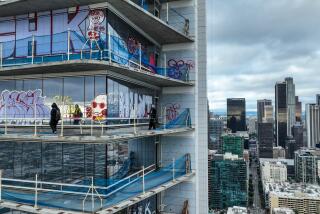Russian skywalkers look upward for escape
MOSCOW — They have discovered a world where no rules or laws apply, where they can be heroes, if only for a few terrifying minutes.
They are skywalkers, or roofers, as they proudly call themselves. The craze, which is believed to have started a few years back with a couple of young Russians, now has hundreds of followers here and thousands of others around the globe.
It works this way: The roofers climb a skyscraper, a construction crane, a tall monument, a tower or a bridge. When they get to the top, they balance themselves — sometimes on the tiniest of ledges — and take a lurch-in-the-stomach picture of the view hundreds of feet below. Then they post it on the Internet.
For these young men (and most are men), skywalking offers an escape from the constellation of problems that beset modern-day Russia, such as finding a job or choosing sides in the war between the Kremlin and the opposition.
“Human problems seem insignificant when you are hanging out on a star,” said Artyom Lakhtionov, 19, a college photography student. “Even traffic jams that paralyze your life down there don’t seem so hopeless.
“It seems scary,” he said, “but it is a situation which you control, and if something goes wrong it is your fault, whereas in the ordinary life down below, anything can happen to you because you have little or no control of this ordinary life.”
It’s a form of escapism that also cries out for attention and recognition, a Moscow psychologist says.
“These young men try to compensate for their acute sense of their own vulnerability and [lack of] self-sufficiency in real life, but they are not to blame for this,” said Alexander Kolmanovsky, head of Our Life, a social psychological rehabilitation center.
“It is not surprising at all that so many of them are in Russia, which is still struggling with the aftereffects of a social cataclysm of global dimension [the break-up of the Soviet Union], which broke most of the old cultural and social traditions without yet creating solid new ones,” he said.
Alexander Remnev, an 18-year-old Moscow computer programming student, usually skywalks with a friend or two for company. They use no mountain-climbing gear, no harnesses or ropes. They wear everyday clothes to make the point that they “are just ordinary guys like you and me and not some boring professionals.”
Remnev says it all began five years ago when he and a friend found an open door to the roof of an 11-story house in downtown Moscow.
It was liberating “to be up there suddenly separated from all your previous life in an entirely different world all to yourself,” Remnev recalled as he sipped tea at a Moscow cafeteria with a couple of his roofer friends, in what he now calls “the old world down below.”
Since then, Remnev, lean and graceful, with a somewhat shy but open smile and a mane of unruly hair, has made hundreds of climbs on roofs and structures in the Moscow area and other parts of Russia.
“You use stairs or the elevator as far as you can go, like an ordinary citizen, and then up there you need to look up for ways to get on the roof, by breaking locks, bypassing obstacles and finding a way to outsmart alarm systems,” he said. “Sometimes we just break in — or rather out — ignoring the alarm that goes off in some office down below.”
And what do the authorities think of that?
“More often than not, they are violating law by breaking and entering,” said Mikhail Pashkin, head of the Russian Police Trade Union, “but if they don’t cause serious damage, they can only be subjected to an insignificant fine.”
Pashkin seemed to harbor a grudging respect for the skywalkers: “I think the state should pay some attention to this group and use them for their and the state’s benefit, like challenging and testing security systems … and finding vulnerabilities in those systems with the help of these daredevils.”
Remnev and his friends won’t disclose how they outsmarted state security officials to reach the roof of the famed GUM department store, which is heavily guarded because it’s an ideal place for snipers who might want to target Red Square. They’ll say only that they made it and saw the Kremlin towers’ red stars and its churches’ golden cupolas glowing in the sunset light.
They’ve also been up four of the Seven Sisters, Stalinist-architecture skyscrapers built in Moscow in the early 1950s. They climbed the spire of Moscow University. They reached the top of one of the tallest — about 1,000 feet — office towers of the new and growing Moscow City complex.
Remnev’s friend and fellow roofer Alexei Nazarov, 20, a computer student, hitchhiked thousands of miles across Russia last summer, a journey that took him a month and a half, to climb to the top of the soaring new bridge that links the eastern port of Vladivostok and the island of Russky.
“I climbed that bridge and sat on top of it as if I had fulfilled the goal of my life,” Nazarov said. “But then I came down and boarded a plane and came back to Moscow and understood that I just climbed another bridge, and started thinking about new exploits.”
Nazarov is admired by roofers around the world as the hero of a vertigo-inducing and sometimes profane YouTube clip that has gotten almost 9 million views. In the clip, Nazarov crawls the length of a beam jutting from a decayed and defunct radio tower near Moscow.
When he reaches the end, he stands up, looking for long seconds at the landscape below, where tall trees with their dark green crowns look like grass. “What the hell are you doing?” scream his friends on the platform. “Come back!”
But he stands there looking, more than 700 feet above the ground, where even a tiny gust of wind could knock him off balance and send him back to earth.
“I felt as high as you can get on your adrenaline when I realized that I can overcome my fear and own and command my body with absolute confidence, something you can never do down on the ground,” Nazarov recalled. “Then I turned and walked back as if I was walking on a street sidewalk and I was as happy as never before.”
When asked whether his mother could be interviewed to give her take on his skywalking escapades, Nazarov exclaimed, “No, please, anything but that! She saw the video and she didn’t approve.”
Remnev, Nazarov and other roofers they know say they don’t drink or smoke. They enjoy life to the fullest when they are literally high, they say.
Remnev recalled with pleasure how he and his friends watched a sunrise from atop the head of the landmark monument to Peter the Great — more than 300 feet above ground — in downtown Moscow.
And he remembered the time they climbed the dome of a mosque in St. Petersburg and were rescued by the police from a stick-wielding crowd of Muslims. That was the only time they’ve been arrested, they say, and they were grateful for it.
The young men laughed when they recalled how Remnev joined a group of budding skywalkers from Minnesota on a tour of Moscow roofs a month ago.
“They will never forget their Moscow experience!” he said, coy about the details.
Psychologist Kolmanovsky predicted that sooner or later, the roofers will have to come down and face reality. But he understands their desire to escape.
“The Russian leadership is least of all — if at all — concerned with the psychological situation of the young generation and is doing nothing to help young people adjust themselves to a life in the society which doesn’t give them a chance to feel they can be successful,” he said.
In the meantime, the roofers are making new plans. They’re thinking about doing climbs in New York and Los Angeles and even tackling Dubai’s Burj Khalifa, the world’s tallest building.
“I have already climbed all the accessible buildings and structures in Moscow, and one day I may run out of things to climb,” Remnev said. “But I know we were the first to do it, and we will live with that notion for the rest of our lives.”
“Hold on a second, don’t you remember how we climbed on the [Moscow] University spire and saw an inscription dated 1971 that so-and-so was there?” countered Lakhtionov.
Remnev was quick to reply, “Well this so-and-so didn’t take the breathtaking pictures we did to prove he was there.”
More to Read
Sign up for Essential California
The most important California stories and recommendations in your inbox every morning.
You may occasionally receive promotional content from the Los Angeles Times.










